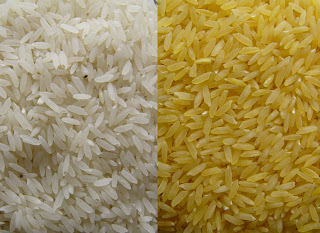July 27, 2016
 |
| Ordinary rice to the left, golden rice to the right. |
Originally printed in the Batesville Daily Guard
Ever hear of Vitamin A?
Sure you have, it’s up there with Vitamins B, C, D, E and K as being essential to a healthful life.
Vitamin A plays a critical role in the maintenance of the body in regards to vision, neurological function, healthy skin, building strong bones, gene regulation, cell differentiation and immune function. It is an antioxidant, thus is involved in reducing inflammation through fighting free radical damage. A high antioxidant diet is a way to naturally slow aging.
The best sources for Vitamin A are eggs, milk, liver, carrots, yellow or orange vegetables such as squash, spinach, and other leafy green vegetables.
But in many parts of the world, many of these things are unavailable in the necessary quantities. This is especially true in areas where the overpopulation and poverty are the norm. The most vulnerable people are the children of Africa and Southeast Asia.
There is one food that is widely available in these parts of the world, though: rice.
The problem though is that rice doesn’t have enough vitamin A to be effective. Naturally, anyway.
That’s where Golden Rice comes in.
Golden Rice is a genetically modified organism. Unlike regular rice, it carries beta-carotene, a major source of Vitamin A, which gives it the color for which it’s named. Like many GMOs, it contains genes that don’t originate in rice. The genes come from daffodils and a bacteria known as Erwinia. I know the word “bacteria” sounds scary to people, but remember, bacteria are on the most part tiny, tiny plants. Like plants, some bacteria are beneficial to us and some are bad for us. Luckily, golden rice has passed the safety standards and is safe for human consumption, like most GMOs on the market.
Clinical trials with adult volunteers from the U.S. concluded that “beta carotene derived from golden rice is effectively converted to vitamin A in humans,” according to the American Journal of Clinical Nutrition. The American Society for Nutrition said that “Golden Rice could probably supply 50 percent of the Recommended Dietary Allowance (RDA) of vitamin A from a very modest amount — perhaps a cup — of rice, if consumed daily.
It sounds good, right? It’s even got the support of the Bill and Melinda Gates Foundation.
Well, instead of sounding like a way to help millions, for many, it was akin to opening Pandora’s Box.
Many anti-GMO activists, particularly Greenpeace, have made it their mission to prevent Golden Rice from being planted by farmers in Vitamin A-poor parts of the world. Aside from spreading conspiracy theories about biotechnology companies, particularly Monsanto, they also attack the plots where the rice itself is grown. In 2013 an trial plot of Golden rice was uprooted by a gang of protesters in the Philippines, claiming that U.S. corporations were only seeking profit.
But why the resistance?
Greenpeace claims “... GE ‘Golden’ rice is a proposed but not practically viable crop solution that has never been brought to market. It is also environmentally irresponsible and could compromise food, nutrition and financial security.” Of course, they never offer any evidence to support their beliefs. Instead, we get inaccurate claims that farmers can’t “save their seeds” or “the rice will contaminate existing species.”
Greenpeace has already been taken to task over this by 110 Nobel Prize Laureates in a letter, pleading with them to stop with the fear mongering.
Greenpeace’s response: The Nobel Prize Laureates didn’t offer “relevant expertise.”
Unfortunately for Greenpeace, nobody aside from anti-GMO activists are getting on board with them. Farmers associations in Nigeria support moving ahead with the cultivation of the rice, as does the Philippine Rice Research Institute. Anti-GMO activists accuse the groups and governments supporting Golden Rice consumption as being “bought by corporations” and have voiced support for radical groups that attack the farms where the rice is grown, destroying the crop.
So does the radical anti-GMO crowd offer an alternative solution?
“Plant sweet potatoes.”
No comments:
Post a Comment